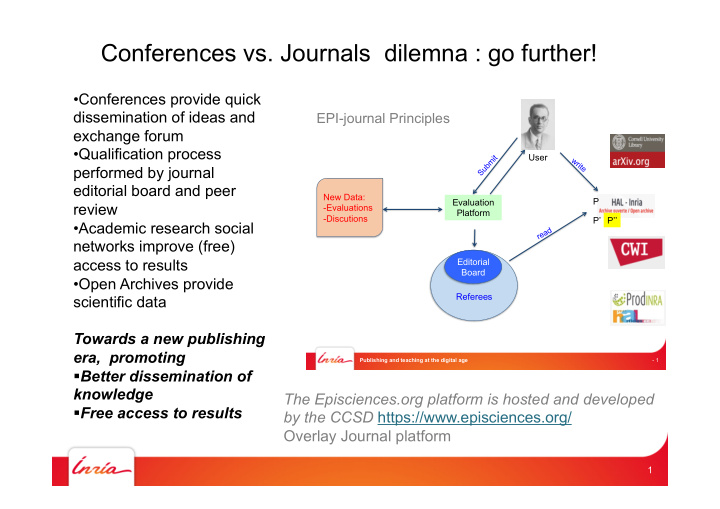



Conferences vs. Journals dilemna : go further! • Conferences provide quick dissemination of ideas and EPI-journal Principles exchange forum • Qualification process User performed by journal editorial board and peer New Data: P Evaluation review -Evaluations Platform -Discutions P’ P’’ • Academic research social networks improve (free) access to results Editorial Board • Open Archives provide Referees scientific data Towards a new publishing era, promoting Publishing and teaching at the digital age - 1 § Better dissemination of knowledge The Episciences.org platform is hosted and developed § Free access to results by the CCSD https://www.episciences.org/ Overlay Journal platform 1
Evaluation criteria (in France: Inria - CNRS, CNU) • Scientific achievement : assessed in terms of ü contributions to the progress of knowledge (publications) ; ü advance of technology (research software and other developments). • Innovation and technology transfer : assessed in terms of technology development activities towards applications and innovations. ü grants from industry and their outcome ; ü involvements into industrial partnership activities and their impact ; ü transfer of research software ; patents ; ü contributions to industrial standards ; ü contributions to startup companies. • Science outreach : scientific events, conferences, talk in a school, in a public library, radio or TV interview. Ø Criteria for Software Self-Assessment (Inria) Ø Criteria for a Self-Assessment of Science Outreach (Inria)
Bibliometry as a measure of impact ? INRIA Evaluation Committee: What do bibliometric indicators measure? Sources : ISI, WoS/Thomson Reuters, Scopus, Google Scholar - CiteSeer, CiteBase Conclusions: Indicators are important metrics, but they must be used in an enlightened manner and according to some basic rules : • Current indicators such as Journal Impact Factor are not dedicated to quality. • One must simply look at orders of magnitude for indicators because even using various sources does not allow a high degree of accuracy. • Expert opinion must be used to correct indicators. • Several indicators must be used. Crosschecking various sources is necessary to obtain relevant information. • Rather than measuring the quality of journals with quantitative indicators, it may be better to categorise them into groups based on the qualitative criteria suggested by researchers themselves. • Comparisons between fields should not be made. How to measure impact ? alternatives for measuring impact : § look at 10 years before (most influencial papers), § look at papers related to licences or cited in relation with successful software.
The Leiden Manifesto for research metrics (Nature, 520, 429-431) Diana Hicks, Paul Wouters, Ludo Waltman, Sarah de Rijcke, Ismael Rafols Ten principles to guide research evaluation 1. Quantitative evaluation should support qualitative, expert assessment 2. Measure performance against the research missions of the institution, group or researcher 3. Protect excellence in locally relevant research 4. Keep data collection and analytical processes open, transparent and simple 5. Allow those evaluated to verify data and analysis 6. Account for variation by field in publication and citation practices 7. Base assessment of individual researchers on a qualitative judgement of their portfolio. 8. Avoid misplaced concreteness and false precision 9. Recognize the systemic effects of assessment and indicators 10. Scrutinize indicators regularly and update them
Recommend
More recommend